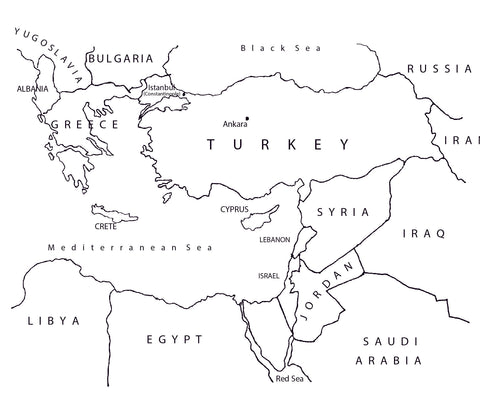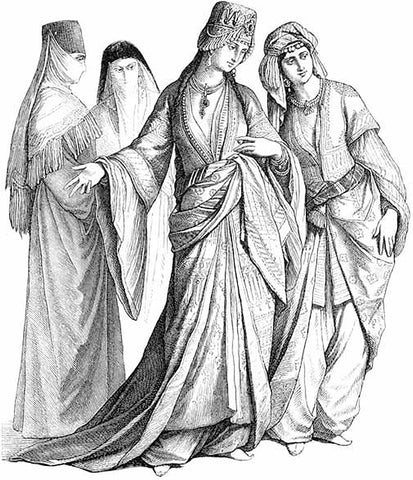- Home
- About
-
Shop
-
Sewing Patterns
-
Fabric
- Sewing Supplies
- Folkwear Clothing
-
- Blog
- Customer Gallery
- Contact
March 12, 2021
by: Cynthia Anderson
There is an allure just in the name of this pattern . . . Turkish Dancer. The sensual lines and aesthetic of the garments seem to tell a hidden story that insinuates a mystique. To fully appreciate this beautiful pattern and to understand it’s origins, you must take a closer look into it’s past.
The making of history is a constant force, but there are times and places when the those forces are so profound, that a cosmic shift seems to occur. This is exactly what happened centuries ago, in a region of the world we now know as Turkey. A perfect brewing of timing, along with the an ideal location, and a plethora of overlapping and unanticipated factors, would create such a powerful and exciting explosive cultural storm, that its sheer impact would maintain its own momentum for centuries. With such a force, it is inevitable that people and the evolution of their clothing would be propelled in tandem as history would be woven. The Folkwear 108 Turkish Dancer pattern represents a selection of garments that come from a blending of multiple cultures over many centuries that is associated with this nexus of history. Turkey’s cultural history became one of the most rich and diverse as any in the world. Due in great part to it’s physical ability to literally connected the east and west, creating a ripe and seemingly ever changing epicenter that would influence a significant part of the world, with an equally exciting and rich array of clothing and textiles to match.

Originally, Turkey was know as Anatolia, which resides on what we know as the Anatolian Peninsula. This outcropping of land is bounded on three sides - the Black Sea to the north, the Aegean Sea to the west, and the Mediterranean Sea to the south. This peninsula served as a natural bridge between Asia and Europe. The orientation of the peninsula resulted in it becoming a central point of trade and therefore saturated with overlapping influences that would culminate over the centuries. One could say that this exchange of cultures, ideas, and goods was one of the first examples of globalization. This long great migration of people would create a fascinatingly diverse place that would influence the world and what it chose to make and wear.
The Turks were originally related to nomadic people of Eastern Upper Asia, and not the Arabs as commonly believed. As the nomads migrated west and south along the trade routes in the Middle Ages, they settled in the rural areas of Central Asia, the northern Arabian peninsula, and eventually the Anatolian Peninsula.
As the Turks gained power in Asia, they infiltrated the Byzantine empire, where they took over more and more territory. After the 6th century the Turks had a dominate presence in Persia (now Iran), Iraq, Eastern Europe, and cemented Anatolia once and for all.
The Turks settled in isolated villages, which ensured many aspects of their inherited Asian cultures were preserved. While at the same time, the proximity of Eastern European and Mediterranean countries influenced and intermingled with their traditions, resulting in an interesting multi-cultural mix. Greek, Roma, Persian, and Arabic cultures had all existed in what is present-day Turkey. This cross pollination of style and design was inevitable. For example, the impact of the geographical closeness of Greece was apparent in the Turk’s Flowing robes, while proximity to the East showed up in the sumptuous embroidery on Turkish textiles.
The Ottoman Empire was formed in 1297 and became the epicenter of Turkish life. By the end of the 14th century, the Ottomans held more territory in Europe than in Asia. Reaching its height in the middle 1500s was marked by advances in government administration, the arts and architecture, and trade agreements with France. At this time, the Ottoman Empire was the largest, strongest, and richest power in the Old World. One can only imagine how interesting and beautiful their clothing must have been! However, as in much of the world’s history, it’s freedoms and resources was relegated to the privilege of men.

What is hard for our modern sense of freedom to fathom, is that half of this plethora of beautiful clothing and culture was hidden out of public sight during the reign of the Ottoman Empire. Because Ottoman women played no open role in public life they were not free to be seen out in the world. If they lived in cities they were confined in to the walls of their homes. If they lived in rural areas they worked in the fields. Women could earn their own money, as long as it did not require any association with men. Typically, women worked as weavers and embroiderers, either in the home or at professional workshops. (Some of these beautiful traditional embroidery patterns and techniques are included in this pattern).
The lives of men and women were segregated in all aspects of life. Even at home, men had their quarters and women and children had theirs. Depending on their families means, women spent their days supervising the work of servants, caring for children, observing religious customs, playing music, sewing and embroidering family linens, dowries, or goods for sale. Because of the limitations on women’s activities and the boredom (and depression) that inevitably resulted, indulgence in opium smoking could occur.
When women left the house, they were required by Islamic law to conceal themselves according to strict rules, usually in enveloping cloaks and veils. Although the Turks descended from Central Asian Buddhists and were exposed to the more inclusive and the freer thinking religions of China, Tibet, India, and Persia, they adopted Islam by the end of the 11th century. Needless to say, the women were not consulted.
The one freeing indulgence that was acceptable for women to engage in was visiting the public baths. Hamman, as the public baths were called, were important social events for women. At the baths, they visit with each other, exchange news and stories (gossip). They worked together on their needlework, ate, and bathed. Women wore their finest clothes to the hamman, where they showed off their dancing abilities and embroidery skills. These women had no idea that their connection to each other, would still hold true through today - through a Folkwear pattern. It is not hard to picture our pattern and all is variations being worn as these women visited, relishing in time to themselves.
History has lead us to believe that women or “sultanas” danced only for men, the truth is that women danced primarily for each other at home in their private quarters or at the baths. If a woman danced for a man, it was strictly in private for their husband only.
Despite half of the Empire’s population being relegated basically to societal non-participation, it continued on. Because of the Empire’s complex historical and cultural diversity, and great climatic and geographical differences, it is an understatement to say there was a great variation in clothing. The reach of the Empire into the Balkans and North Africa influenced the look of indigenous dress, and customary Ottoman dress was, in turn, influenced by the indigenous costumes of those areas. One can identify many common features of costumes across the Empire, yet the integration of regional characteristics made for a beautiful mosaic of Turkish dress.
As history would have it, even great empires are not immune to decline no matter how long and illustrative their histories might be. The Ottoman Empire would prove unsustainable, due to internal strife and corruption. Outside powers would gain an upper hand, which would exacerbate the loosening grip of the empire. Despite this slipping of power, the decline would last several centuries more before the Empire ended. The Empire finally dissolved upon the close of World War I in 1918. In 1922, the last Turkish sultan was overthrown and modern Turkey was born.
Once again a new storm brewed - changing world factors would create another tectonic shift and send history off into new trajectory, dragging behind it old relics that still remain. The grip of history has changed little for women who still live within these ancient cultural norms. This may also explain why creating beautiful clothing and textiles was such an essential outlet for so many women throughout history. The one constant about history is that it never stops playing itself out and some constructs do change, for better or worse. The important part is to have a better understanding of the past, so we can better reshape the present and future. This is a lot to contemplate, but much of history evolves in the quiet recesses of daily life.
Folkwear patterns are more than just clothing patterns. We hope to inspire and provoke interest in the deeper value of how clothing has helped shape the world. We believe that sewing is made richer and therefore more enjoyable when you understand more about the garments you have been inspired to make - including their histories and cultures. Each Folkwear pattern comes with a past life and an incomplete history lesson, as well as “how to’s” using authentic techniques to not only inspire your sewing, but to also create a meaningful link to the past. Folkwear hopes to celebrate each pattern we promote, with a mindful appreciation of the origins and culture that each pattern represents. Clothing is a beautiful way to link ourselves to others. But, to gain a true understanding and respect of all people, it is equally important to look a little deeper into the truths and realities of history and to see how deeply our own reflection looks back at us in the mirror. The evolution of what we wear rarely happens in a clear linear fashion, but manifests in a twisting sequence of often challenging occurrences, as does life.
The next time you use a Folkwear pattern to make a garment that is all your own, we hope you feel a connection, learn something new, and realize you are helping to keep history alive.
We hope you will enjoy making the garments in the 108 Turkish Dancer Pattern and integrate these basic pieces into your person wardrobe, in your own unique way. As always, we love seeing what you are inspired to make!
P.S. Don't forget to check out the blog where you will learn how to make binding and a front button-loop closure for the Folkwear 108 Turkish Dancer Entari and vest.
December 12, 2024 7 Comments on Turkish Dancer Pattern History
